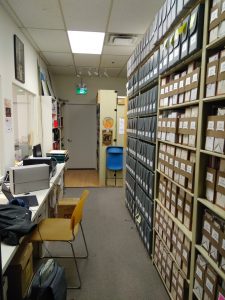I have been traveling around Vancouver in order to visit the artists and do the interviews, so today was the first day of on-site work in a while. It was nice to see people in VIVO again, I found out a few changes though; for instance, Audrey, whom I worked with at the archive and library, has left VIVO recently after finishing her project. I usually sit in the corner of the office area and work on my laptop, however, today I stayed in the archive area where Audrey used to work. I had some recordings to edit, the artist research for my next interview with Crista Dahl, and I was also expecting ‘a meeting’ (this was rather a casual conversation) with Karen regarding my project’s next step -creating an audio archive which is really exciting!
It was easier for me to talk to Karen because her workspace is around the archive shelves in the library and I was sitting right behind the shelf and then her desk. When I came in, Karen was busy making phone calls. She told me that the person she was going to talk with was very chatty and she had another phone call after that so had to get done everything in time. She seemed a bit stressed while she was waiting for a call (I relate that to myself when I had to call artists that I never met in person to explain my project and set up a meeting time). Before I start editing audios, even hearing how Karen speaks and communicates on the phone was very interesting to me and I learned a lot by that. So, I think that physically being close, working in the same space, is important! This little lesson also reminded me Pascal Gielen’s article on immaterial labour and his discussion around communication at a workplace. Being able to have a chat/informal conversation with my supervisor may have little to do with my productivity, but this is an essential skill to develop trusts between us that might allow me to speak up those undeveloped ideas, in my opinion. I don’t actually know what exactly Karen is working on (I only know that she has lots of projects going on), but from what I observed during my hours, her work is much in the form of communication (emails, phone calls, talking with other VIVO people).
I shared five audio files of the interviews with Karen. In order to support the material (the interview recordings), I was told to provide my short bio and information of the project (location, date, and the project description). I worked on the writing and that made me think through what I have been doing for the past weeks, reflecting my initial goals for the project and what it looks like to me after the interviews. Writing and summarizing also helped me to think about the project as a whole -while I didn’t have any fixed or standard questions, and I interviewed different generations of artists and they gave it different perspectives, I think that that gave it an interesting insight to Media art – its development and the divergence. As I mentioned, I haven’t done the interview with Crista yet, so it’s missing the last piece, but I’m surprised at looking at how each interview made the project somehow coherent under the theme of video art. After I’ve done the writing and added to the file, I did more research on the last interview subject, Crista Dahl. I have been researching on her since October, however, because she has a long career and many stories, especially about the Video Inn, it was hard to choose what to ask. I was reading the book that Karen gave it to me, where Crista was interviewed about the development and history of VIVO, and that was very helpful for me to understand about Crista as well as the foundation of the artist-run-centre. I spoke to Crista over the phone last week to set up a time for an interview, and she suggested me to take a look at the Video Guide magazine, which was published in 1978-1992 by the Satellite Video Exchange Society. I went through VIVO’s online archive of the Video Guide. Then I started listing up interview questions to her, mostly focusing on what ideas were discussed at that time, and what the motivation was and the people’s lifestyles looked like at the start when there was very limited amount of money for the labors.

photo of my workspace in the archive library